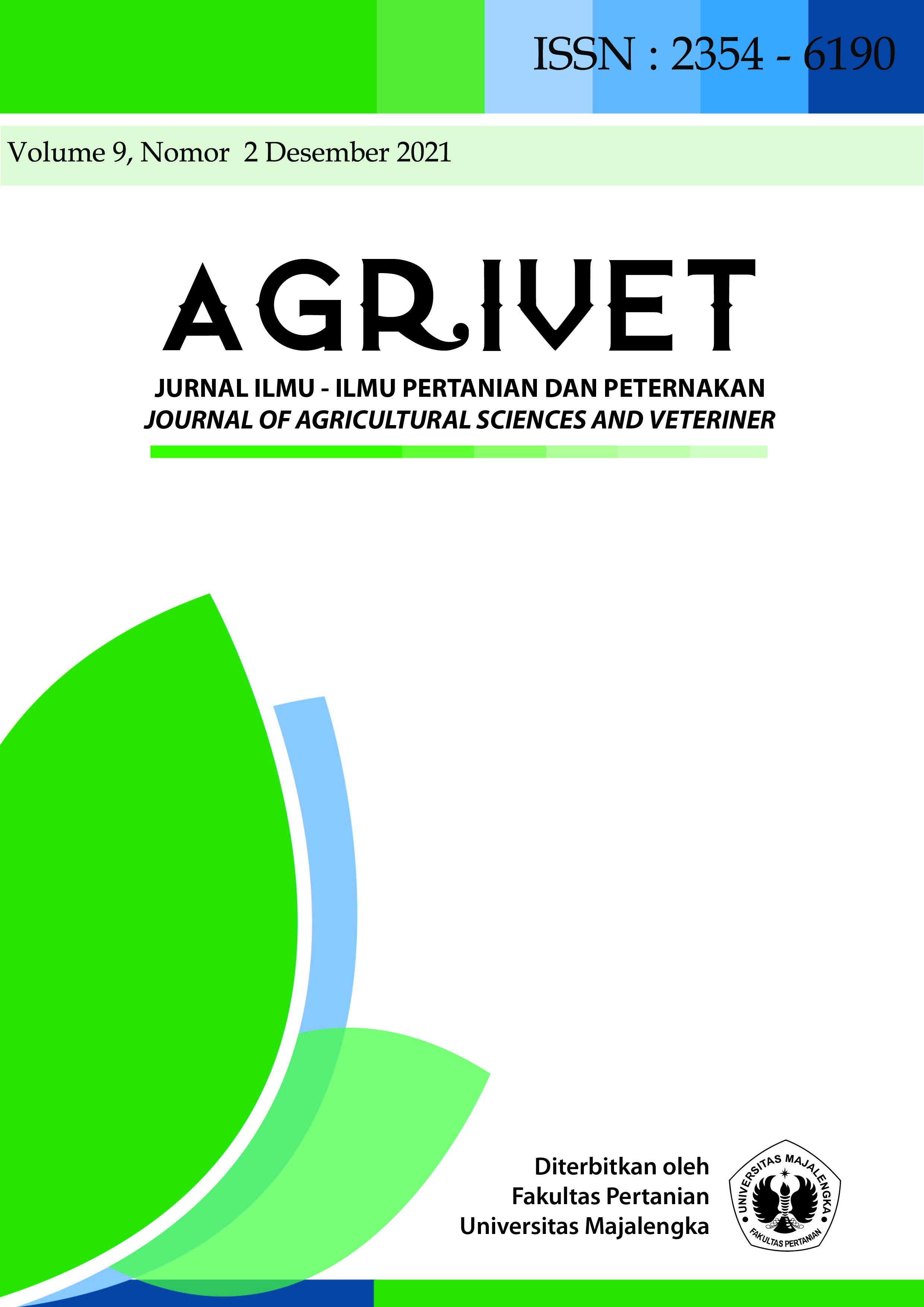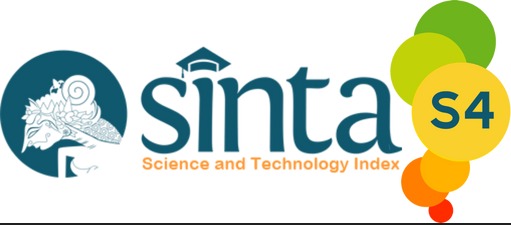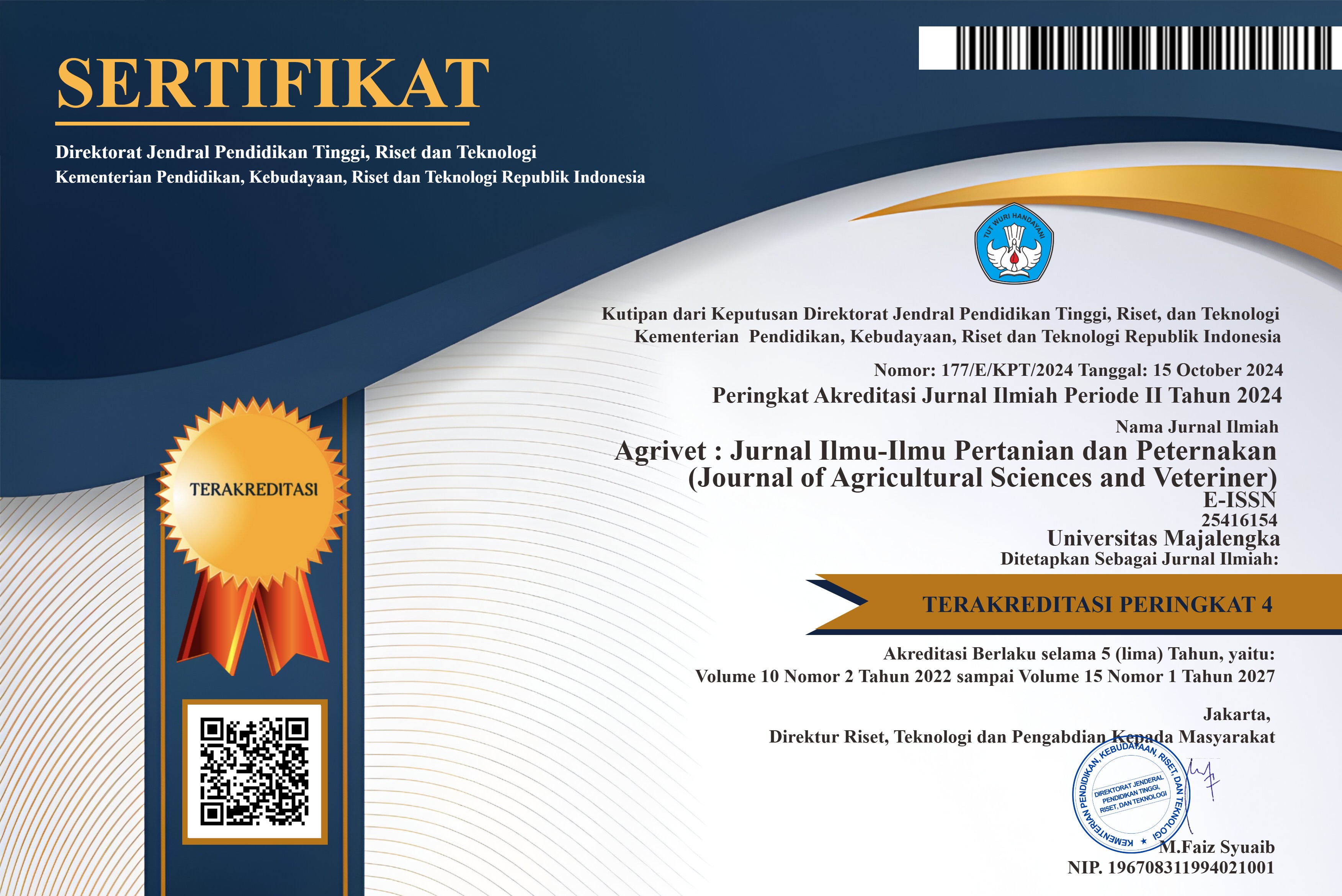SINERGISME INOKULASI B. japonicum dan MIKROBA PELARUT FOSFAT TERHADAP PERTUMBUHAN DAN HASIL TANAMAN KEDELAI
DOI:
https://doi.org/10.31949/agrivet.v9i2.1763Abstract
Penelitian ini bertujuan untuk menganalisis sinergisme antara inokulasi B japonicum dan mikroba dan pelarut fosfat dan dosis optimum pada pertumbuhan dan hasil tanaman kedelai. Percobaan dilakukan di lahan Balai Penyuluhan Pertanian (BPP) Kecamatan Majalengka Kabupaten Majalengka Jawa Barat pada bulan Maret sampai dengan Juni 2021. Rancangan yang digunakan dalam Percobaan ini adalah Rancangan Acak Kelompok (RAK) dengan Pola Faktorial. Faktor pertama dosis inokulan B. japonicum (R) dan faktor kedua dosis Mikroba Pelarut Fosfat (P). Hasil penelitian menunjukkan bahwa Secara sinergis Inokulasi B. japonicum pada dosis 5 g kg-1 benih dan mikroba pelarut fosfat 50 kg ha-1 dapat meningkatkan jumlah nodula efektif sebesar 110,48% dan nisbah pupus akar sebesar 13,83%. Dosis Inokulasi B. japonicum 5 g kg-1 benih menurunkan jumlah nodula tidak efektif sebesar 46,54%, meningkatkan diameter nodula efektif sebesar 1,75%, meningkatkan indek luas daun sebesar 14,69%, meningkatkan jumlah polong sebesar 16,04%, menurunkan jumlah polong hampa sebesar 3,62%, meningkatkan bobot polong per tanaman sebesar 17,20%, meningkatkan bobot 100 biji sebesar 1,55%, meningkatkan bobot biji per tanaman sebesar 17,20%, dan meningkatkan bobot bibi per petak sebesar 16,99%. Dosis 150 kg ha-1 dapat meningkatkan diameter nodula efektif hingga 0,98%, menurunkan jumlah polong hampa 29,82%.
Keywords:
Kedelai, Pertumbuhan, hasil, Bradyrhizobium japonicum,, Mikroba Pelarut FosfatDownloads
References
Dubbs, W. E., & Grimes, H. D. (2000). The mid-pericarp cell layer in soybean pod walls is a multicellular compartment enriched in specific lipoxygenase isoforms. Plant physiology, 123(4), 1281–1288. https://doi.org/10.1104/pp.123.4.1281.
Fischinger, S. A. and Schulze, J. 2010. The importance of nodule CO2 fixation for the efficiency of symbiotic nitrogen fixation in pea at vegetative growth and during pod formation .Journal of Experimental Botany, Page 1 of 11.
Gastal, F. and Lemaire, G. 2002. N uptake and distribution in crops: an agronomical and ecophysiological perspective. J. Exp. Bot. 53 (370): 789-799.
Hikosaka, K and Niels P. R. Anten. 2012. An evolutionary game of leaf dynamics and its consequences for canopy structure. Funcional ecology. Volume26, Issue 5. October 2012. https://doi.org/10.1111/j.1365-2435.2012.02042.x
Hubber, A. M., Sullivan, J.T., dan Ronson C.W. 2006. Symbiosis-Induced Cascade Regulation of the Mesorhizobium loti R7A VirB/D4 Type IV Secretion System. MPMI Vol. 20, No. 3, pp. 255–261.
Isherword, K. F. 1998. Fertilizer use and environment. In: N. Ahmed and A. Hamid (eds.), Proc. Symp. Plant Nutrition Management for Sustainable Agricultural Growth. NFDC, Islamabad. pp. 57-76.
Khan, A.A., Jilani, G., Akhtar, M.S., Naqvi, S.M.S, Raseed, M. 2009. Phosphorus Solubilizing Bacteria: Occurrence, Mechanisms and their Role in Crop Production. J. Agric. Biol. SCI. 1(1): 48-58.
McDermott, T. R. dan Graham, P.H. 1989. Bradyrhizobium japonicum Inoculant Mobility, Nodule Occupancy, and Acetylene Reduction in the Soybean Root System. Appl Environ Microbiol. 55(10): 2493–2498.
Nielsen, R. L. 2006. N Loss Mechanisms and Nitrogen Use Efficiency. Purdue Nitrogen Management Workshops, Purdue University.
Raun, W. R. dan Johnson, G. V. 1999. Improving Nitrogen Use Efficiency for Cereal Production. Review dan Interpretation. Agronomy Journal, Volume 91:357–363.
Santosa, E. 2007. Mikroba Pelarut Fosfat. Dalam Saraswati, R., Husen, E., dan Simanungkalit, R.D.M. Metode Analisis Biologi Tanah. Selected reading, hlm. 55-68. Balai Besar Litbang Sumbrdaya Lahan Pertanian. Badan Penelitian dan Pengembangan Pertanian. Deptan.
Salon,C. Nathalie G. Munier-Jolain, Gérard Duc, Anne-Sophie Voisin, David Grandgirard, et al.. Grain legume seed filling in relation to nitrogen acquisition: A review and prospects with particular reference to pea. Agronomie, EDP Sciences, 2001, 21 (6-7), pp.539-552. ff10.1051/agro:2001143ff.
Schulz, T.J., Thelen, K.D., and Wang, D. 2005. Effect of Bradyrhizobium japonicum Inoculant on Soybean Growth and Yield. Michigan State University, Crop and Soil Science Department
Singh T. dan Purohit, S.S. 2011. Biofertilizer Technology. Agrobios (India).
Shu-Jie, M., Yun-Fa, Q., Xiao-Zeng, H.. 2007. Nodule Formation and Development in Soybeans (Glycine max L.) in Response to Phosphorus Supply in Solution Culture. Pedosphere 17(1):36-43.
Tsvetkova, G. & Georgiev, G. 2003. Growth, Nodulation and Dinitrogen Fixation Related to the Changes of Phosphate Fractions of Nodules and Leaves of Phosphorus Starved Soybean (Glycine max L. Merr.) Plants. Comptes Rendus de l'Academie Bulgare des Sciences, vol.56, p.9:47
Vance C.P. 2001. Symbiotic Nitrogen Fixation and Phosphorus Acquisition. Plant Nutrition in a World of Declining Renewable Resources. Plant Physiology vol. 127 no. 2 390-397.
Waluyo S.H,, Lieb T. A. dan Mannetje L. 2004. Effect of Phosphate on Nodule Primordia of Soybean (Glycine max (L.) Merrill) in Acid Soils in Rhizotron experiments Indonesian of soybean 37-44.
Wasule, D., Wadyalkar S. and Buldeo, A., 2007. Effect of phosphate solubilizing bacteria on role of Rhizobium on nodulation by soybean. First International Meeting on Microbial Phosphate Solubilization Developments in Plant and Soil Sciences, Volume 102, 139-142, DOI: 10.1007/978-1-4020-5765-6-20.
Zarei, I., Sohrabi1, Y., Heidari1, G.R., Jalilian, A. and Mohammadi, K. 2012. Effects of biofertilizers on grain yield and protein content of two soybean (Glycine max L.) cultivars. African Journal of Biotechnology Vol. 11(27), pp. 7028-7037.
Published
How to Cite
Issue
Section
License
An author who publishes in the Jurnal Agrivet agrees to the following terms:
- Author retains the copyright and grants the journal the right of first publication of the work simultaneously licensed under the Creative Commons Attribution-ShareAlike 4.0 License that allows others to share the work with an acknowledgment of the work's authorship and initial publication in this journal
- The author is able to enter into separate, additional contractual arrangements for the non-exclusive distribution of the journal's published version of the work (e.g., post it to an institutional repository or publish it in a book) with the acknowledgment of its initial publication in this journal.
- The author is permitted and encouraged to post his/her work online (e.g., in institutional repositories or on their website) prior to and during the submission process, as it can lead to productive exchanges, as well as earlier and greater citation of the published work












